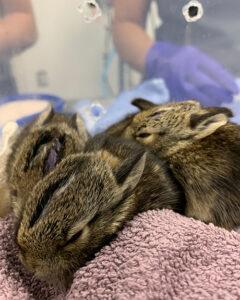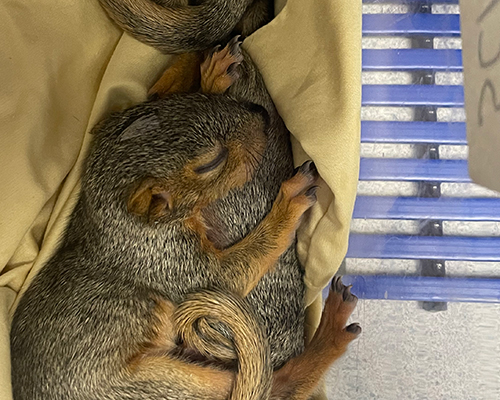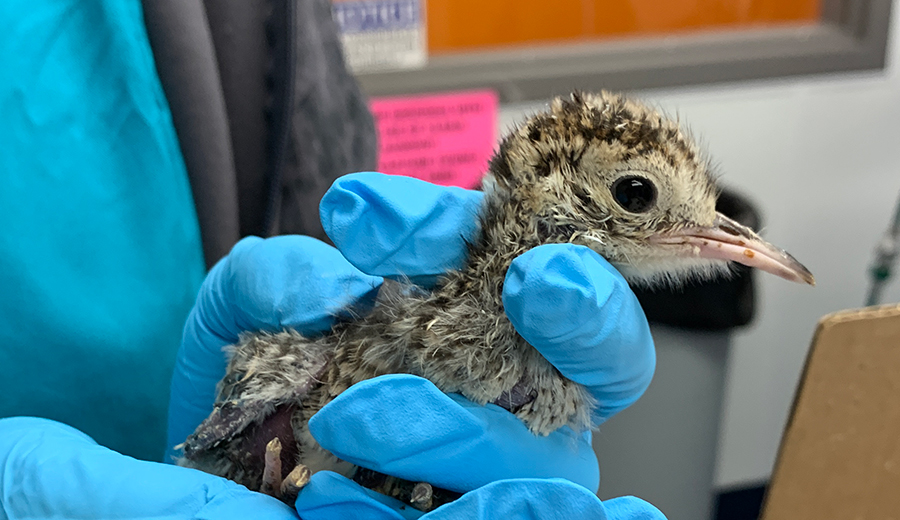This time of year, people begin to notice baby birds hopping on the lawn, while their pets begin to find hidden bunny nests. It’s orphan season, when wildlife have offspring and some of these offspring end up needing extra care.
Spring is the busiest time of year for the University of Illinois Wildlife Medical Clinic. Unfortunately, some of the wildlife babies brought to our clinic are not orphans at all. Instead, they are normal, healthy babies mistaken for orphans because well-meaning people did not realize the baby’s parents were still providing care. Dr. Stephany Lewis, director of the Wildlife Medical Clinic, explains how to tell the difference between a wildlife baby that needs help and one that doesn’t.
What Is Orphan Season?
Orphan season may begin in late February and last through August or September, depending on the species. At the Wildlife Medical Clinic, orphan season means lots of time and work for veterinarians and student volunteers.
“We get a lot of phone calls and a lot more patients brought to us,” Dr. Lewis explains. “It’s partly because there are more babies out there and people are finding them, but it’s also because people are more active. They’re outside, and they’re finding injured, sick, and orphaned animals.”
When a sick or orphaned animal is brought to the clinic, it receives a full intake examination by both a student and a doctor, who together develop a treatment plan.
“Depending on the case, these patients may be with us a week to several weeks before their medical problems are resolved,” says Dr. Lewis. “At that point, they get released near where they were first found if they appear to be functioning normally. If not, we will transfer them to a wildlife rehabilitator who specializes in raising that species.”
However, not every wildlife baby brought in for help is an orphan. Separating a healthy baby from its parents and its own species decreases its likelihood of survival.
So, how can you tell if an animal needs medical care?
Baby Bunnies
Eastern cottontails’ nests are covered on the ground and are visited by the mom only once at dawn and again at dusk.

“A lot of people will find these nests and there’s no mom in sight, so they think the babies have been abandoned. Then they pick the bunnies up and bring them to us,” Dr. Lewis explains.
To determine whether a nest is being visited by the mom, people can sprinkle flour around the nest or put ribbon in a pattern over the nest, then check to see if it gets disturbed.
“The majority of the time, baby bunnies don’t need to come in unless you can see that they’re injured or they’ve been caught by a cat,” says Dr. Lewis. “Any animal that has been in a cat’s mouth needs help because cats carry a type of bacteria called Pasteurella multocida in their saliva. Any puncture wound, even one that’s too small to see, can cause a life-threatening infection.”
Dogs may cause fractures or wounds that aren’t easily noticed. Any bunny caught by a dog should also get medical care.
Baby Squirrels

Baby squirrels often wind up on the ground because they fell out of the nest or their nest was disturbed. Placing them back in their nest or in a wicker basket nearby will give these squirrels their best chance to reconnect with mom. Even if the nest has been destroyed, the mother squirrel often has a back-up nest that she will move her babies to if given enough time.
“If you handle them, they’ll scream, and that’s actually helpful. It tells the mom where they are. As long as they’re not injured, they should be fine for up to 12 hours before mom locates them,” Dr. Lewis states.
Many people believe that touching a wildlife baby means the mother will reject it. This is just a myth. “That is not true for any species—mammals, birds, etc.,” says Dr. Lewis. “You can put them back, and we encourage people to put them back.”
Baby Birds, Deer, and Opossums
Other wildlife young that people commonly encounter include songbirds, fawns, and opossums.
Songbirds spend three to five days on the ground as fledglings before they can fly.
“If they haven’t developed their feathers yet and they’re on the ground, lying down, or looking dull or injured, then they should be brought to us,” Dr. Lewis says. “But if they are fully feathered, hopping around the ground and not flighted, they are probably just healthy fledglings. The parents are around nearby to continue to feed them.”
Like cottontails, fawns are normally left alone while their moms forage. Fawns can be considered orphans if they are crying out, walking around, and covered in ticks. If they appear healthy and are curled up in the grass, their mom is likely returning to care for them.
Opossums can be on their own when their bodies, from nose to butt (not including the tail), measure 6 inches. That’s about the size of a dollar bill. When they are this size, opossums are no longer dependent on mom and are not orphans.
It is often difficult to know when an animal may be an injured adult, a normal neonate, or an orphan. For help, you can send emails containing photos or videos to the Wildlife Medical Clinic at WMCchair@vetmed.illinois.edu. We can help people determine which animals need care and which should be left alone.
What to Do—and What Not to Do—in the Meantime
If you find an animal that is indeed an orphan or requires medical care, there are steps you can take while waiting to take it to a wildlife rehabilitator or to bring it to the Wildlife Medical Clinic.
“We advise that people not feed them anything. Almost anything can survive 12 to 24 hours without any food or water,” Dr. Lewis explains. “Unfortunately, an attempt at feeding likely causes more harm than good. That’s because feeding an inappropriate food can lead to severe problems with the GI tract. Also, feeding in an inappropriate manner can end up with food particles in the lungs.”
Water placed inappropriately with the young poses a risk of drowning.
“I recommend putting the animal in a small box in a dark quiet place and keeping them warm. The animal should be handled as little as possible,” Dr. Lewis instructs. “Keep in mind that human beings are a predator species to pretty much any wildlife. Even when the animal is not showing obvious signs of distress, they are usually really stressed out that we’re handling them.”
She also urges people to avoid peeking at the animal all the time and talking around them. If the wildlife baby becomes habituated to humans through excessive exposure, its chances of survival go down because it will not have the normal prey response.
The main takeaway for anyone who wants to be helpful to wildlife during orphan season? Be sure that the animal truly is orphaned or injured before interfering with it.
“The absolute best thing for the animal is for them to stay with the parents,” says Dr. Lewis.
By Lauren Bryan
Editor’s note: The young bird, which was cared for at the Wildlife Medical Clinic, featured at the top of this page is an upland sandpiper, which is an endangered species native to Illinois.




